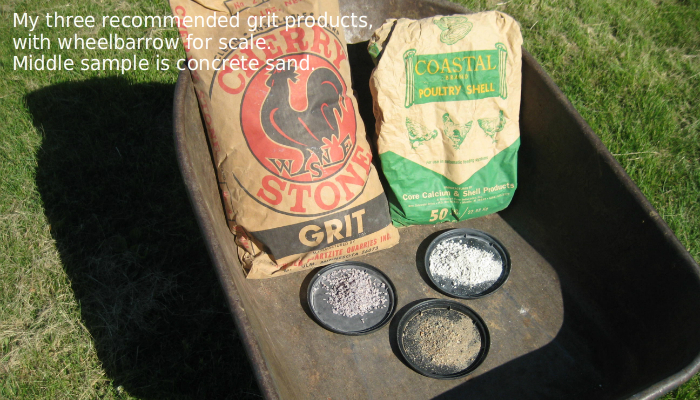The Bird Grit Problem, and a Solution

Birds do not have teeth to chew their food. Instead, chunks of food are swallowed into a muscular gizzard that contains mineral grit for grinding. Even birds as small as hummingbirds have been observed eating tiny grit, presumably to grind the tiny insects they hunt.
Before colonization, sand bars in streams were important sources of hard and insoluble grit minerals like quartz and feldspar. And more importantly, empty clam shells in various stages of disintegration paved the bars. The mineral in clam shells is soft calcium carbonate, which is exactly the same chemical composition females need for their eggshells and their developing birdlings. Wetlands also produced snails, whose shells are made of calcium carbonate. Every Iowa County originally had its rivers, streams, and wetlands, and both hard and soft grit were a widespread resource.
The problems with “natural” bird grit today include:
- The sandbars are now made of mud, and contain few clamshells.
- The wetlands are drained and grow grain, not snails.
- Lead shot is now abundant across the landscape, and even one BB ground down in a bird’s gizzard can make it sick or die. A slow-flying sick duck is a favorite target for a peregrine falcon or eagle, thus lead poisoning goes up the food chain. The same problem occurs with lost lead fishing tackle.
- Vast quantities of granular insecticides are spread on agriculture fields, and birds can mistake these toxic granules for mineral grit.
- Rural roads are paved with crushed local rock. In our area, about half is limestone, which is the desirable calcium carbonate, and half is dolomite, a limy rock containing a lot of magnesium, which makes mammals and birds sickly when it is consumed in excess. Limestone and dolomite look alike.
- City street grit contains ground rubbish that includes bits of electronic waste, brake linings, broken glass, crushed plastic, etc.
There is no realistic way to evaluate the whole grit picture for birds in your neighborhood: how much lead shot is lying around from bygone eras, how much dolomite is in the road rock, etc. But it is easy and inexpensive to simply create locations with good quality grit to help mitigate the “natural” grit problems birds may have.
I sprinkle grit on our pebble driveway, put handfuls on top of stumps, and toss some wherever I’m exposing bare dirt. Three good products I recommend are:
- Crushed oyster shell: This is identical to broken clamshell, is sold as chicken grit, and contains a mix of sizes from powder to quarter-inch chunks.
- Quartzite grit: This is crushed quartzite, a very hard and angular grit especially good for grinding. Several sizes are available for larger birds at local farm cooperatives in 50-lb bags.
- Concrete sand: This contains a range of sizes from fine sand to small pebbles, which generally span the range from little birds to pheasants. (Mason sand has been screened down to just the smaller sizes. This is available at lumberyards by the bag, or at the sand pit by the truckload.)
So if you suspect a shortage or a problem with grit for birds in your area, just find a location around your place that will not get overgrown with weeds, and give the birds some quality grit to scratch around in and pick out what they need.
When I first started putting out grit around our rural place a quarter century ago, the grit was used up and scattered rather quickly. Today it lingers long, perhaps in part because there is now a considerable residue scattered about from previous applications. And I also now have wetlands and ponds producing lots of snails.
Many of the things we do to make the world a better place, like conserving fuel or recycling tin, provide no prompt feedback, and we proceed on green faith. And providing quality bird grit is another proactive example, and we will never really know who benefitted. Fortunately, grit is of no interest to rats or squirrels, so you can store it in the garage or on the porch without consequences. And if your driveway gets too icy in winter, a couple handfuls of quartzite grit provides great traction.
Photo note: The quartzite is initially too coarse for the small birds, but I put it in our lane and our tires gradually crush some of it to finer sizes.


